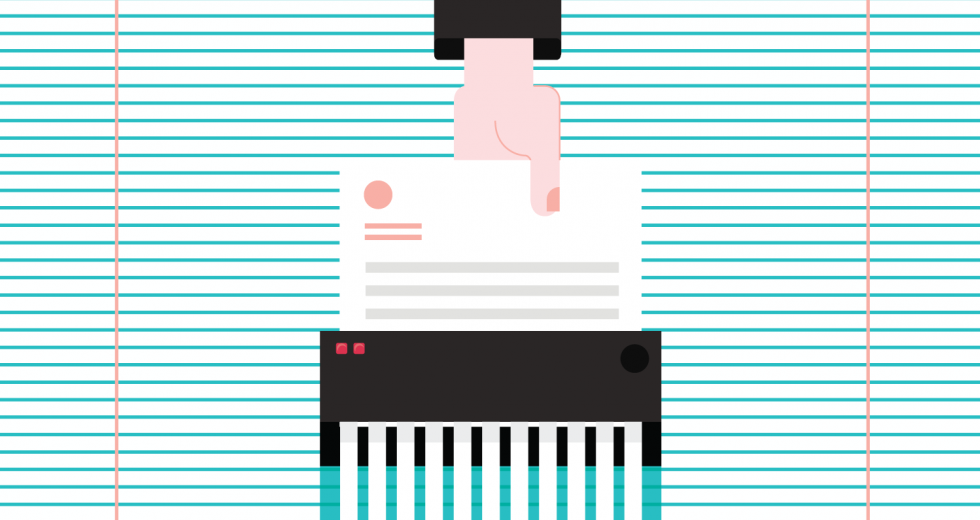Every company’s brand collateral begins with the best intentions. There’s usually a business card, maybe some letterhead and envelopes, possibly a brochure. Then more people get hired, and their names don’t fit the original design. You run out of envelopes and need a reprint, but the preferred paper stock is no longer available. Maybe someone decides they need a branded postcard, and then another wants to hand out some branded pens. Your once clean and simple identity devolves into a mishmash of colors, fonts and paper styles. Your logo gets squished and squeezed until everyone loses all concept of its original form.
It all just gets away from you until one day you find yourself standing in your office’s storage room staring at boxes of mismatched promotional items wondering what happened. Before this spins into a full-blown business identity crisis, take charge and detox your branding collateral.
Step 1: Go back to the brand.
The first step in our marketing detox series (“Detox your Brand,” April 2015) talked about cleaning up your identity. Whether you went through that process or already have a strong understanding of your image, knowing how your business is perceived — the history, story, voice, tone and expectations people experience when working with your brand — is key to creating a strong and orderly identity system.
Clarifying your brand will help you know:
- What kind of business you are and what services you need to promote.
- Your goals and focus areas.
- How your brand should look and sound, whether that be humorous, technical, casual or otherwise.
- Who your current and potential customers are and how they want to hear from you.
- How much of your budget to allocate.
Step 2: Finalize your logo.
Your logo is the single most essential element in your brand identity system. If you don’t have a strong logo, or if your team has been a bit too flexible in its use, it’s time to grab the reins. Decide what the final version of your logo will look like. This process can get technical, but these elements are important. Handle it head-on and with precision.
Finalize your main colors. These need to be defined as CMYK (cyan, magenta, yellow and black) for professional print purposes, RGB (red, green, blue) for digital uses, HEX codes for websites (for example, white #FFFFFF) and possibly a Pantone spot color if exact matching on all materials is essential (for example the red for Coca-Cola). Close versions of CMYK and RGB are usually good enough for most brands.
Related: Focus Groups in 3 Easy Steps
Create a black option. If you can avoid shades of black and keep it solid, a black-and-white version of your logo can serve as a one-color option if needed. When appropriate, printing in one color versus CMYK can save you big money.
Create options for vertical and horizontal needs. Having only a single option inevitably leads to logo shrinking or squeezing when a special need arises. Protect your logo from poor placement choices by providing multiple variations.
Step 3: Create a style guide.
You know your brand, and you’ve finalized your logo. Now it’s time to put some rules in place. A style guide is an easy-to-reference document that shows anyone designing something for your brand what to do (and what not to do).
A good style guide will have sections for:
- Logo look and use, including color options and how to use your logo appropriately on both dark and light backgrounds.
- Alternate marks that allow flexibility for users, including the horizontal and vertical versions of the brand, ways to use the logo with just the icon or just the text, or any other acceptable elements of the logo to be used as standalone pieces.
- Color palette, including the number builds for CMYK, RGB and HEX codes, Pantone names and shade percentages if you include a grayscale option.
- Typography, including fonts and recommended sizes for elements such as the logo, headlines and body copy. Keep these as simple as possible. If you have a special font for your logo design, consider choosing a basic alternative for general uses.
- Any additional visual elements, such as social media avatars, photographic elements, programmatic icons for specific services or product lines, and so on.
- Brand voice basics that define what your brand sounds like for selected marketing uses.
Related: Toxic-Content Cleans — Make sure you’re getting the most out of your webiste
Step 4: Design your identity package.
Finally, pull it all together and choose the actual physical elements your business will use to best meet its goals. This could include anything visual that represents your business. As a foundation, and depending on your specific needs, consider developing:
- Business cards
- Letterhead
- Envelopes
- Labels
- Brochure
- Flyers or rack cards
- Notecards
- One-sheets for specific products or services
- Direct mailers
- Promotional handout items
- Product packaging
- Apparel for employees
- Building and directional signage
- Event banners and tablecloths
Additional digital elements (other than a website) could include:
- Email signature
- Email newsletter template
- PowerPoint templates
- Word templates
- Sales presentations
- Social media avatars and header images
If you’ve stumbled across an old box of branded golf balls you don’t even remember purchasing, it’s time to detox your brand collateral. The best way to keep your identity system manageable — and targeted — is to keep it under tight control. After all, as I often remind my own team, “Structure equals freedom, and freedom equals profit.”



